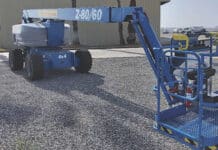By Charlie Green
From the June 2024 Issue
In a rapidly evolving corporate environment, office managers grapple with an array of challenges that go beyond traditional administrative tasks. Today’s modern office manager faces the ever-expanding challenge of office and workspace management, which encompasses everything from facilities maintenance and real estate management to ensuring regulatory compliance and creating a positive work environment. The complexity of these tasks is often overwhelming, time-consuming, and fraught with potential for costly errors. These pain points need innovative solutions, and this is where Computer-Aided Facility Management (CAFM) software emerges as a game changer.

Everyday Challenges In Office Management
Office managers play a critical role in maintaining the seamless functioning of the workplace. Their responsibilities span across administrative tasks, including space planning, managing employees, coordinating with external vendors, implementing safety procedures, overseeing office maintenance, and handling procurement. However, this extensive remit comes with numerous pain points. One major challenge is managing excessive workloads, given the expansive scope of responsibilities and the constant juggling of tasks. In a 2014 Unison Survey with school office administrators, 93% of respondents expressed concern about their workload. One participant explained, “the biggest concern is the increase in workload but no increase in office hours…the assumption is that I will manage anything and everything.”
Office managers are tasked with maximizing space usage, ensuring safety, accommodating fluctuating needs, and aligning space planning with business growth, all of which can be daunting in the face of limited resources and rising real estate costs.
Communication issues also abound, with office managers often acting as the linchpin in interdepartmental communication, vendor coordination, and employee interactions. Lastly, the efficient utilization of space is another significant concern. Office managers are tasked with maximizing space usage, ensuring safety, accommodating fluctuating needs, and aligning space planning with business growth, all of which can be daunting in the face of limited resources and rising real estate costs.
How CAFM Solutions Addresses Pain Points
In the corporate arena, office managers wear an array of hats, embodying roles that span from receptionist to administrator. They grapple with a myriad of responsibilities, including but not limited to staff hiring and training, public relations, form control, accounting, purchasing, and safety compliance. A study conducted by Workfront in 2022 reported that 60% of office managers claimed they are saddled with tasks that are not included in their job descriptions, highlighting the expansive nature of their role.
Managing such an extensive array of tasks can drastically affect productivity. Multiple studies, including a seminal research piece by Stanford University, have shown that multitasking often reduces efficiency and increases mental stress. This is primarily because the human brain isn’t designed for simultaneous task execution; instead, it switches rapidly between tasks, leading to cognitive strain and potential errors. To compound the challenge, office managers often encounter an increasing workload that doesn’t correspond to an expansion of office hours. This discrepancy creates an unsustainable pace, leading to stress, potential burnout, and decreased productivity.
Within this context, CAFM software emerges as an empowering solution for office managers struggling with excessive workloads. The software’s central strength lies in its ability to automate numerous routine tasks such as scheduling maintenance, assigning resources, tracking assets, and managing space allocation. This automation significantly reduces the manual workload, allowing office managers to be more efficient with their time.
A survey by ServiceNow in 2023 highlighted that 86% of executives believe automation will increase productivity. By delegating repetitive tasks to CAFM, office managers can focus more on strategic decisions, such as workforce planning, budgeting, and improving operational efficiency, thereby increasing their productivity and reducing the risks of burnout.
Furthermore, CAFM software’s reporting and analytics capabilities enable office managers to better understand and manage their workload. They can track time spent on tasks, identify bottlenecks, and allocate resources more effectively. This data-driven approach enables them to prioritize tasks and manage their time more efficiently, ultimately leading to a more balanced and manageable workload.
Overcoming Communication Challenges
Office management stands at the crossroads of multiple operations, and central to its successful execution is effective communication. With the evolving corporate landscape, office managers find themselves navigating increasingly complex communication challenges. A 2022 study by Smartsheet revealed that 40% of office workers spent more than a quarter of their workweek on repetitive tasks such as emails, data collection, and coordination — tasks that can be significantly streamlined by effective communication.
Office managers frequently encounter roadblocks in interdepartmental communication due to disparate systems, contrasting schedules, and varying departmental goals. Moreover, the emergence of hybrid workforces, which blend remote and on-site employees, adds another layer of complexity. Coordinating schedules across different time zones, managing resources for fluctuating on-site attendance, and promptly addressing employee concerns are tasks that can quickly become overwhelming.
Against this backdrop, the integrated communication features of CAFM software serve as a powerful tool for streamlining and enhancing communication processes. The software offers a centralized platform where office managers can not only post updates and manage schedules but also coordinate effectively with different parties involved in office operations. By consolidating communication, CAFM reduces the risk of fragmented information and minimizes the potential for misunderstandings that could disrupt operations. A 2022 McKinsey report found that employees spend an average of 20% of their workweek looking for internal information or tracking down colleagues for help. By providing a centralized repository for necessary data, CAFM software drastically cuts down this time.
In essence, CAFM software takes the herculean task of communication in office management and transforms it into a well-orchestrated symphony. By centralizing, integrating, and streamlining communication, office managers can focus more on strategic decision-making and less on repetitive coordination tasks. The result is a smoother, more efficient, and more harmonious workspace, reflecting the true potential of modern office management.
Space Utilization Optimized
One of the primary pain points that office managers encounter is the efficient utilization of space. The Bureau of Labor Statistics reported in 2022 that commercial real estate costs in urban business districts have surged by 30% over the past decade, meaning effective space management is paramount. This task becomes more complex with changing business needs, requiring continual adjustments to office layouts.
CAFM software offers immense benefits for office managers. Its ability to simplify and automate complex tasks can result in significant time and cost savings.
In this landscape, the spatial intelligence capabilities of CAFM software emerge as a transformative solution. One key feature that sets CAFM apart is its ability to provide a digital twin — a highly accurate digital representation of the physical office space. This visual platform offers a granular overview of the workspace, making tangible the abstract concept of space allocation. For instance, office managers can virtually map out seating arrangements, optimizing them to foster better team collaboration and improved inter- and intra-team communication. A survey by Gensler Research Institute in 2022 found that strategic seating arrangements could enhance employee productivity by up to 15%, underscoring the importance of this feature.
De-Risking The Labor Shortage: It’s All About Flow
Persistent labor shortages can greatly inhibit productivity, but integrating Digital Labor Flow Optimization can prevent this. Read more…
Can CAFM Help Your Office Management Efforts?
After assessing the pain points and the solutions provided by CAFM software, it’s clear that this technology offers immense benefits for office managers. Its ability to simplify and automate complex tasks can result in significant time and cost savings. Additionally, it facilitates informed decision-making based on real-time data, thereby allowing managers to proactively tackle potential issues.
Most importantly, by taking care of these time-consuming tasks, CAFM software enables office managers to focus on what truly matters — creating a productive and enjoyable work environment.
 Green is Senior Research Analyst at Comparesoft. CAFM, SMB’s, Facilities Management and Digital Transformation are his areas of expertise. Charlie holds a masters degree, which allows him to offer data-led and empirical research-driven reports.
Green is Senior Research Analyst at Comparesoft. CAFM, SMB’s, Facilities Management and Digital Transformation are his areas of expertise. Charlie holds a masters degree, which allows him to offer data-led and empirical research-driven reports.
Do you have a comment? Share your thoughts in the Comments section below, or send an e-mail to the Editor at jen@groupc.com.




















![[VIDEO] Job Order Contracting: Accelerating the Projects that Matter](https://facilityexecutivemagazine.kinsta.cloud/wp-content/uploads/2024/05/maxresdefault-324x160.jpg)
